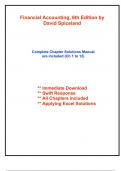Exam (elaborations)
Solutions for Financial Accounting, 6th Edition by Spiceland (All Chapters included)
- Course
- Institution
Complete Solutions Manual for Financial Accounting, 6th Edition by David Spiceland, Wayne Thomas, Don Herrmann ; ISBN13: 9781260786521...(Full Chapters are included and organized in reverse order from Chapter 12 to 1)...Chapter 1: A Framework for Financial Accounting Chapter 2: The Accounting Cycl...
[Show more]



